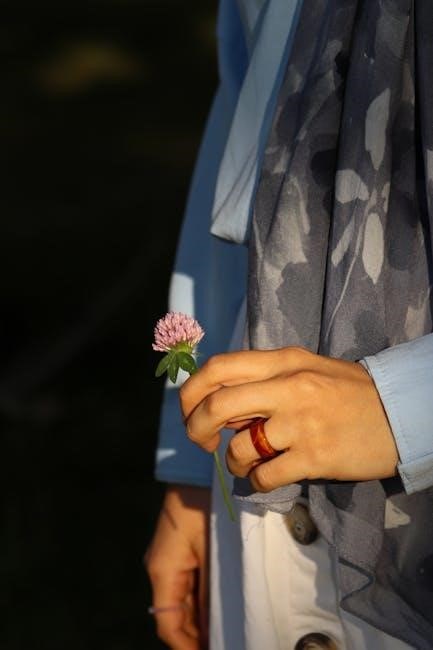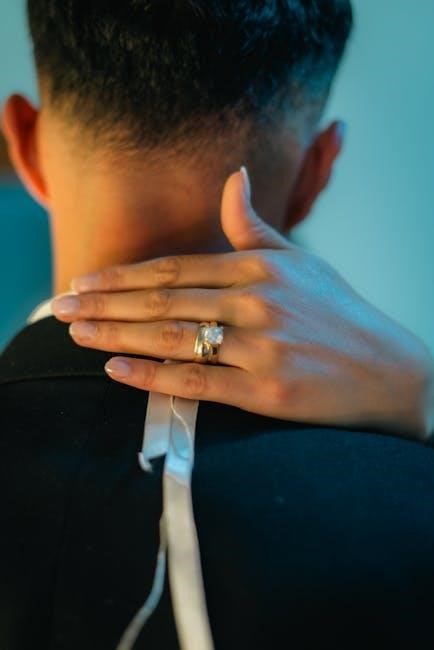A ring guide is an essential tool for ensuring the perfect fit and comfort of your jewelry. It helps you understand sizing systems, measure accurately, and choose the right style for your needs, making your purchase decision easier and more confident.
Understanding the Importance of Proper Ring Fit
A proper ring fit is crucial for both comfort and aesthetics. A ring that is too tight may cause discomfort or restrict blood flow, while one that is too loose risks slipping off and getting lost. Correct sizing ensures the ring sits securely and comfortably on the finger, enhancing the overall wearing experience. Proper fit also preserves the longevity of the ring, as ill-fitting jewelry is more prone to damage. Additionally, the right size ensures the ring looks proportionate to the hand, completing the desired style. Measuring accurately is essential, as even small discrepancies can significantly impact comfort and functionality. Factors like temperature and time of day can affect finger size, making it important to measure under normal conditions for the best results. A well-fitting ring is not just practical but also a key element of its appeal.
Overview of Ring Sizing Systems Worldwide
Ring sizing systems vary widely across different countries and regions, reflecting local standards and preferences. In the United States, ring sizes are typically numbered, ranging from 3 to 13, while in Europe, sizes are often based on the internal diameter of the ring in millimeters. Other countries, such as Australia, may follow their own unique sizing conventions. This diversity can sometimes lead to confusion for consumers shopping internationally. To address this, many jewelers provide conversion charts to help customers align their size across different systems. Understanding these variations is essential for ensuring a proper fit, whether purchasing domestically or abroad. Additionally, some jewelers offer printable ring sizing guides to assist customers in determining their size accurately at home, further simplifying the process of finding the perfect fit regardless of location.
Ring Sizing Fundamentals
Ring sizing fundamentals involve knowing your size, considering band width, and understanding how materials affect fit. Accurate measurement ensures comfort and proper wear, essential for any ring.

How to Measure Your Finger Accurately
To measure your finger accurately, start by using a flexible measuring tool like a string or a printable ring sizer. Wrap the string around the base of your finger, marking where it overlaps, and then measure the length in millimeters. For best results, measure at the end of the day when your fingers are at their largest. Avoid measuring when your hands are too hot or cold, as this can cause temporary swelling or shrinking. If you have an existing ring that fits well, you can measure its internal diameter using a ruler. Consider the ring’s style and material, as wider bands or certain materials may require a slightly larger size. For precision, try both the string method and a printable tool to ensure an accurate measurement before purchasing a ring.
Best Times to Measure Your Finger for Sizing
The best time to measure your finger for ring sizing is at the end of the day, when your fingers are at their largest due to natural swelling. Avoid measuring when your hands are too hot or cold, as this can cause temporary changes in finger size. Consistency is key, so ensure you measure at the same time each day for accurate results. If you have a medical condition that causes frequent swelling, consider consulting a jeweler for professional guidance. For the most reliable measurement, use a flexible tool like a string or a printable ring sizer, and take note of any differences between your left and right hands. Proper timing ensures a comfortable and precise fit for your ring.
Differences in Ring Sizes Between Men and Women
Ring sizes differ between men and women due to variations in finger anatomy and style preferences. On average, women’s ring sizes range from 3 to 9, with size 6 being the most common. Men’s ring sizes typically range from 8 to 14, reflecting larger finger circumferences. Women’s rings often feature narrower bands, while men’s rings tend to have wider bands for a more robust look. Finger shape and size also play a role, as men generally have thicker fingers compared to women. Additionally, personal style influences size choices, with some women preferring delicate designs and men opting for bold, statement pieces. Understanding these differences helps in selecting the right ring size for comfort and aesthetics. Size 6 remains a popular choice for women, while men’s sizes often start at 9 and go up to accommodate larger fingers.

Methods for Determining Ring Size
Methods for determining ring size include using a printable ring sizer, measuring with an existing ring, or utilizing a ruler or measuring tape for accurate finger measurement.
Using a Printable Ring Sizer Tool
A printable ring sizer tool is a convenient and accurate method to determine your ring size at home. Many jewelers, such as Chaumet and Cartier, offer downloadable guides that you can print on standard A4 paper. To use the tool effectively, ensure your printer settings are correct to maintain the scale. Place the tool on a flat surface and measure the internal diameter of an existing ring or wrap it around your finger, aligning it with the marked sizes. This method is particularly useful for those who prefer online shopping, as it ensures a precise fit without the need for in-person measurements. Always double-check the measurements to avoid resizing hassles later. This tool is a reliable way to find your perfect ring size comfortably from home.

Measuring with an Existing Ring
Measuring with an existing ring is a straightforward method to determine your size accurately. Simply place the ring on a ruler or measuring tape and measure the internal diameter in millimeters. This diameter corresponds directly to standard ring size charts. Ensure the ring is well-fitting, as this will provide the most accurate measurement. For best results, use a ring that fits the finger you intend to wear the new ring on, as sizes can vary slightly between fingers. This method is particularly useful for those who already own jewelry and want to match the size precisely. It eliminates the need for multiple measurements and ensures comfort and proper fit. By using an existing ring, you can confidently determine your size without professional assistance, making it a practical solution for anyone.
How to Use a Ruler or Measuring Tape
Using a ruler or measuring tape is a simple and effective way to determine your ring size. Start by placing the ring on a flat surface and positioning a ruler or measuring tape across the inner diameter. Ensure the ruler is in millimeters for precision. Measure the diameter from one inner edge to the other, making sure the ring is aligned straight. This measurement will correspond to standard ring size charts, allowing you to find your correct size. For accuracy, avoid measuring when your hands are cold or hot, as this can affect finger size. This method is ideal for those who prefer a hands-on approach or do not have access to a printable sizing tool. It provides a reliable way to measure your ring size at home, ensuring a proper fit and comfort.

Ring Size Comparison Charts
Ring size comparison charts help convert sizes across different countries, ensuring accurate fits. They include standard fashion ring sizes, making it easy to determine your size globally.
Converting Sizes Across Different Countries
Ring sizes vary internationally, with different systems used worldwide. The US uses numerical sizes, while Europe often uses alphabetical letters. A reliable conversion chart maps these sizes, ensuring accurate fits. Understanding the internal diameter or finger circumference measurements helps in precise conversions. International standards or jewelry associations provide official charts for accuracy. When purchasing from another country, knowing your size in their system is crucial for proper fit. Online calculators or printable charts simplify the process. Step-by-step instructions guide users on how to use these tools effectively. Ensuring accuracy is key to guarantee the ring fits well. This guide helps anyone convert ring sizes confidently across different regions.

Understanding Standard Fashion Ring Sizes
Standard fashion ring sizes are categorized to fit various finger shapes and preferences. Common sizes range from 3 to 13 for women and 6 to 14 for men, with size 6 and 7 being the most popular for women, and size 9 or 10 for men. These sizes are based on the internal diameter of the ring, measured in millimeters. The standard system ensures consistency across jewelers, making it easier to find the perfect fit. Factors like finger shape and knuckle size can influence the ideal size. Rings can often be resized, but understanding your standard size helps in selecting the right piece. This guide provides a clear overview of standard sizes, ensuring confidence in your jewelry choices.

Additional Considerations for Ring Fit
Consider lifestyle and comfort when choosing a ring. Factors like activity level, job requirements, and personal preference for tight or loose fit can impact the ideal size and wearability.
Factors Affecting Ring Comfort and Sizing
Several factors influence ring comfort and sizing, including temperature, activity level, and weight fluctuations. Measure your finger at the end of the day for accuracy, as fingers swell slightly. Avoid sizing when hands are hot or cold, as this can lead to inaccurate measurements. Lifestyle also plays a role—active individuals may prefer a slightly looser fit. Additionally, personal comfort preferences, such as tight or loose wear, should be considered. Ensuring the right balance between fit and comfort is crucial for long-term wearability. These factors help determine the ideal size for a ring that feels comfortable and secure throughout the day.

Stacking Rings and Sizing Tips
Stacking rings can add a stylish touch to your look, but it requires careful sizing to ensure comfort and proper fit. When stacking, consider the total width of the rings, as this can affect how they sit on your finger. If you plan to wear multiple rings, you may need to size up slightly to accommodate the added thickness. Thicker bands or statement rings may require a larger size than delicate stacking rings. Additionally, personal comfort plays a role—some prefer a snug fit, while others opt for a looser feel. To achieve the perfect stack, measure your finger with the rings you plan to wear together or consult a jeweler for guidance. Balancing style and comfort is key to enjoying your stacked ring look. Always consider the activity level and lifestyle when choosing sizes for stacked rings, as this can impact long-term wearability and satisfaction.
Choosing the right ring size ensures comfort and style. Use guides, measure accurately, and consider fit preferences for a perfect, satisfying purchase that complements your personal taste.
Final Tips for Choosing the Perfect Ring
When selecting the perfect ring, ensure accurate measurement by using a printable ring sizer or consulting a professional jeweler. Consider factors like metal type, band width, and personal comfort. Measure at the end of the day for the best fit, as fingers can swell. For women, sizes typically range from 3 to 9, with 6 being the most common. Men’s sizes are generally larger, often between 8 and 14. Stackable rings may require a slightly larger size for comfort. Remember, proper fit ensures both style and comfort. Always verify sizing charts and consider the ring’s design, as wider bands may need a larger size. Finally, double-check measurements before making a purchase for a flawless fit.
Where to Find Additional Resources
For further assistance in determining your ring size, explore resources from reputable jewelers and online platforms. Many offer downloadable ring size guides, such as Chaumet’s printable A4 sheet, to help you measure accurately at home. Jewelry experts and designers provide detailed sizing charts and conversion tools on their websites. Some brands, like Cartier, offer printable sizing tools that you can download and use instantly. Additionally, jewelry blogs and forums often share tips for measuring and fitting rings, including advice on stacking and comfort. Online marketplaces like those offering wedding rings also provide step-by-step guides for sizing. For personalized advice, consider visiting a local jeweler or reaching out to customer support teams for tailored recommendations. These resources ensure you find the perfect fit with confidence and ease.
